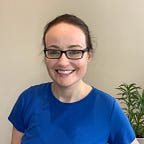Stripping, Drugs, Neurosurgery: Living With Epilepsy
Somehow, the first seizure I recall makes me giggle. I was getting changed after sports at school, age 6-ish, when I had a focal seizure, a seizure that starts on one side of the brain.
The problem really was that I was still only half-dressed when I started walking down the corridor in only my underwear. It wasn’t until I was about to enter the classroom that I came out of the seizure. Can you imagine how different my life might have been if I had half-flashed my classmates?!
Little did I know that my brain was misbehaving. I was having generalized absences (where I’d lose awareness for a few seconds at a time) and focal seizures for years before they were even noticed. I called them “funny feelings” and found them kind-of relaxing!
At age 10, doctors measured my brain waves, but didn’t find anything wrong. The diagnosis was from my description alone. It was epilepsy.
My seizures got worse in severity and frequency over the years. I was having tonic-clonic (also known as grand-mal) seizures, where I’d lose complete consciousness, stiffen and fall to the floor shaking.
I was taking Anti-Epileptic Drugs, which were helping but didn’t get rid of all of my seizures. The negative side-effects of both the seizures and the drugs on my memory, mood, energy levels, and overall cognitive function were awful.
Accidents I’ve experienced as a result of seizures include: falling off of my bicycle into the middle of the road, falling over on a mountain whilst skiing (I fell asleep in the snow after a seizure, which was comfortable at least), falling onto a railway line (thank goodness for the fast-acting public and staff who helped me), fracturing my clavicle by smashing it on the desk at work (which required two surgeries).
I had a focal seizure at work where I went for a wander and started stripping…in front of more than 200 people. A tonic-clonic swiftly followed. I came-to with my skirt up around my waist! My wonderful colleagues very kindly covered me up!
My neurologist at the time, Dr. Tim Wehner at the UCL Hospital for Neurology & Neurosurgery, was brilliant; he was so empathetic, honest, caring, and he made me laugh. In one appointment, I explained how depressed I was and how hopeless I felt. I’d been on so many different combinations of drugs that just didn’t work.
They all had horrid side effects, too. I was desperate.
Dr. Wehner asked me a question that had been on my mind for a while. I don’t remember exactly how he said it to me, but it was something along the lines of, “Your life expectancy isn’t great. Would you consider surgery?”
I grinned and said: “Yes, sure, scoop it out if you can.”
After all of my scans, my neurological and psychiatric exams, and more, I turned out to be one of the one in a hundred of those with epilepsy who are eligible for surgery. I was excited: the risks of having surgery were low compared to the risks of not having it at all. I was 31.
A neurosurgeon removed much of my left temporal lobe, the part of my brain where all of my seizures started. The impact of my surgery has been positively life-changing. They were unable to remove all of my damaged brain tissue, but I now have far fewer seizures, have a greater life expectancy, and can plan my life a bit more! I also take lower dosages of medication and have far fewer injuries to recover from!
I had depression prior to surgery (which is very common in those with epilepsy) but slipped into an even deeper depression after surgery. Even though my doctors half-expected this, it was overwhelming, nonetheless. (This story is for another day.)
Also as expected, my cognitive function, which had already been frustrating, to say the least, worsened after the surgery. Although my memory improved significantly after recovery from surgery, my memory is still (and sometimes hilariously) terrible.
It’s a never-ending challenge to live with such abnormal brain activity — but at least it’s interesting!
The neuroscientists and researchers investigating our extraordinary brains provide us with a positive focus and hope for the future. Reading (and sometimes even remembering) excerpts from research from professionals at organisations such as King’s College London, Epilepsy Research UK, Epilepsy Foundation, University of Melbourne, Boston University, Toronto University, and more; give us hope.
Through SciReach (founded by Science Unsealed editor Ben Marcus), it’s been wonderful to find so many fun, intellectual, and progressive minds who are learning more about the human brain!
Neuroscience can even be beautiful! I was stunned by the beauty of the Purkinje cells shown by Science Unsealed editor Dana Simmons!
Now I bridge that gap between neuroscientists, neurologists, patients, and the rest of the population through public speaking, consulting, social media, and Epilepsy Sparks — the blog, with online training in the pipeline.
My purpose is to empower those affected by epilepsy (there are over 70 million of us) through education. I commonly reference empirical evidence to combat the oh-so-prevalent anecdotal, and sometimes misinformed, “evidence” out there.
If you’d like to learn more about my work, check out The Epilepsy Sparks blog where we have those with epilepsy, neurologists, neuroscientists, and more, educate us all about one of the most common neurological disorders in the world.
If you have a comment or question, I’m always game to chat on Twitter at torierobinson10
This article first appeared on Science Unsealed from the Illinois Science Council.
